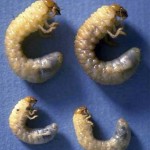Description
White grubs are the immature stages of May or June beetles, commonly called “June bugs.” There are more than 90 species of scarab beetles in Texas that are considered to be white grubs or May and June beetles. Their biologies are similar, but they differ in distribution, habitat preference, length of life cycle and seasonal occurrence.
Common white grub species belong to the genus Phyllophaga, with P. crinita being particularly common in Texas on bermudagrass, St. Augustinegrass and tall fescue. The southern masked chafer and the green June beetle are other species within the white grub group. The Japanese beetle has recently been detected in some Texas counties.
White grubs are whitish, C-shaped larvae (up to 1-inch long) with brown head capsules and chewing mouthparts. They have three pairs of legs (one pair on each of the first three segments behind the head); this separates them from larval hunting billbugs (weevils), which they otherwise superficially resemble.
Habitat, Life Cycle and Food Source
White grubs feed on the roots of many plants including turfgrasses, weeds, vegetable transplants and ornamentals. Larvae develop mainly during the fall and spring. During extreme environmental conditions (cold, drought), the larvae burrow deeper into the soil. In Texas pupation occurs mainly during the spring.
Damage
Severely damaged turfgrass dies and can be rolled up like a carpet because of the lack of roots. Heavily infested lawns are attractive to moles, raccoons, skunks and armadillos, which dig through the surface to feed on the grubs.
Management
Adults of many May and June beetle species begin emerging in February. However, peak emergence of turf-infesting species usually occurs during late June in central Texas, somewhat earlier in South Texas and later in North Texas.
Peak adult emergence is important because approximately 5 weeks later eggs laid by mated females will hatch. This is the best time for insecticide treatment to prevent white grub damage where there is a history of white grub problems.
Insecticides are most effective when the turf is watered thoroughly just before and after treatment. Turfgrasses that are highly fertilized and frequently watered have a thick thatch layer and/or are grown in highly organic soils are most vulnerable to attack.
The need for insecticide treatments also can be determined by sampling for white grubs. One proposed action level is four grubs per square foot. Applying insecticide while white grubs still are small prevents unnecessary damage to turf and increases the chances that the chemical will be effective in controlling the grubs.

